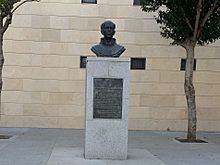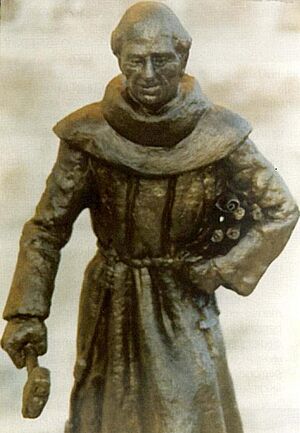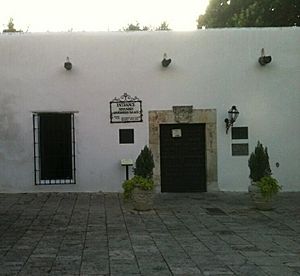Antonio de Olivares facts for kids
Quick facts for kids
Antonio De Olivares
|
|
|---|---|

Monument to Fray Antonio de Olivares in Moguer
|
|
| Born |
Antonio de San Buenaventura y Olivares
1630 |
| Died | 1722 (aged 91–92) |
| Nationality | Spanish |
| Occupation | Franciscan |
Antonio de San Buenaventura y Olivares, often called Fray Antonio de Olivares (1630 - 1722), was a Spanish Franciscan friar. He is famous for helping to found the city of San Antonio, Texas. He also led the first Catholic Mass ever held in Texas.
Fray Antonio de Olivares helped start several important places. These include the Alamo Mission in San Antonio (which you might know as just the Alamo), the Presidio San Antonio de Bexar, and the Acequia Madre de Valero.
Who Was Antonio de Olivares?
Antonio de San Buenaventura y Olivares was born in Moguer, Andalusia, Spain, in 1630. He studied to become a Franciscan friar at the San Francisco convent in Moguer.
His Early Life and Journeys
In 1665, when he was 35 years old, Antonio de Olivares traveled to the Americas. He went with 19 other religious people. In the Convent of Querétaro, Mexico, he learned how to work with native people. This training helped him teach them about Christianity.
From this monastery, friars went on many trips to Texas. Texas was a very important area for the Spanish government. In 1675, Fray Antonio de Olivares and other friars explored the land beyond the Rio Grande. They wanted to see if new towns could be built there.
On January 1, 1699, Olivares was chosen to work in northern Coahuila, which is now part of Mexico. There, in San Juan Bautista, he joined Father Francisco Hidalgo. On January 1, 1700, they helped start Mission San Juan Bautista.
In 1700, Olivares also founded Mission San Bernardo and Mission San Francisco Solano. These missions were about 5 miles from the Rio Grande in Coahuila. Later, in 1706, he became the leader of the College of Santa Cruz de Querétaro for three years.
Founding San Antonio
In 1709, Fray Antonio de Olivares joined an expedition led by Pedro de Aguirre. With Fray Isidro de Espinosa, they explored the area from modern-day San Antonio to the Colorado River. That same year, he went to Spain. He wanted to convince the Spanish leaders that it was important to build new missions along the San Antonio River. He stayed in Spain for six years.
In 1716, Fray Antonio wrote to the Viceroy of New Spain, Baltasar de Zúñiga y Guzmán. He shared his hopes for a new mission and asked for families to come and settle a town. He also said that some families should be skilled in useful trades. This would help teach the native people to become "useful and capable citizens."
Fray Antonio's hard work paid off. The Viceroyalty officially approved the mission in late 1716. They gave the job of starting it to Martín de Alarcón, the governor of Coahuila y Tejas.
Fray Antonio de Olivares began organizing the new mission. He often met with the local Payaya Indians and earned their trust. He helped recruit the Pastia Indians to build the San Antonio missions. He stayed at the mission site, working with the native people. They built a simple structure of straw, branches, and mud near the San Antonio River.
This mission was named San Antonio de Valero. The name came from "San Antonio de Padua" and the Viceroy of New Spain, Marquess of Valero. The mission was near a community of Coahuiltecan people. It was first home to about four native tribes who had converted from Mission San Francisco Solano.
Fray Antonio had an accident while crossing a bridge. His animal slipped, and he fell, breaking his leg. When he recovered, the mission had moved to the west side of the river. This new spot was safer from floods. Fray Antonio de Olivares then moved Mission San Francisco Solano to the new Mission of San Antonio de Valero.
He also built the Presidio San Antonio de Bexar. This fort was on the west side of the San Antonio River, about a mile from the mission. Its purpose was to protect the missions and settlements in central Texas. It also helped Spain keep its claim to the land from other European countries. The fort was made of adobe with a grass roof. Soldiers lived in brush huts. Settlers gathered around the fort and mission, forming the town of Bejar or Bexar. This town became a strong Spanish defense in Texas.
The whole complex was completed with the first canal in Texas, the Acequia Madre de Valero. This canal was 6 miles long. It was built to water 400 hectares of land and provide water for the people. It was very important for the missions to control water from the San Antonio River for crops and people. This aqueduct was the start of a much larger water system.
The Acequia Madre de Valero ran from what is now Brackenridge Park south to Hemisfair Plaza. Part of it even runs under the Menger Hotel. The aqueduct was fixed up in 1968 and was named a Recorded Texas Historic Landmark.
Fray Antonio de Olivares got help from the Payaya Indians to build a bridge. This bridge connected the Misión de San Antonio de Valero and the Presidio San Antonio de Bexar. They also helped build the Acequia Madre de Valero.
On May 1, 1718, Don Martin de Alarcón officially gave Fray Antonio de Olivares control of the Misión de San Antonio de Valero. This mission later became known as "The Alamo."
On May 5, the Presidio San Antonio de Bexar was founded. It was on the west side of the San Antonio River. This is where the city of San Antonio, Texas, grew from. About 30 families settled around the area.
On July 8, 1718, the first baptism happened at the new Mission San Antonio de Valero. This event is recorded in the mission's baptism book.
In 1719, another friar, Margil, wanted to start a second mission in San Antonio. Father Olivares did not agree with this. But on February 23, 1720, the Franciscans from Zacatecas founded Mission San José y San Miguel de Aguayo next to the San Antonio River.
On September 8, 1720, after breaking his leg and having poor health, Olivares left Mission Valero. He went back to the monastery in Querétaro, where he passed away in 1722.
See also
 In Spanish: Antonio de Olivares para niños
In Spanish: Antonio de Olivares para niños




